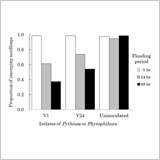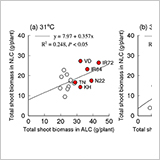Review
Leaf Photosynthesis and Its Genetic Improvement from the Perspective of Energy Flow and CO2 Diffusion
Y. Tanaka, E. Kumagai, Y. Tazoe, S. Adachi and K. Homma
- This paper reviews the recent achievements of research on the physiological determinants of the leaf photosynthetic capacity from the perspective of energy flow and CO2 diffusion.
- Photoinhibition in the photosystem, environmental response of mesophyll conductance, and morphological factor affecting stomatal and mesophyll conductance were reviewed.
- Although the association of leaf photosynthesis with crop productivity still has a large ‘missing link’, these achievements strongly suggest that the leaf photosynthetic capacity can be genetically improved in crop species.
Abstract Full Text PDF[768K] |
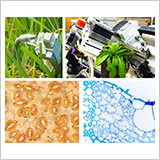 |
Crop Morphology
Tillering Responses to High Red/ Far-Red Ratio of Four Japanese Wheat Cultivars
M. Toyota, N. Tatewaki, M. Morokuma and A. Kusutani
- The effect of high red: far-red ratio (R:FR) on tillering response in wheat and its cultivar differences were investigated with pot experiment.
- The high R:FR significantly increased the maximum number of tillers per plant and delayed the cessation of tillering in all cultivars.
- In conclusion, the increase of the tillers in high R:FR were attributed mainly to the delay of the cessation of tiller emergence, along with the significant increase of site-filling in some cultivars.
Abstract Full Text PDF[740K] |
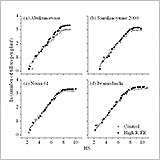 |
Role of Abscisic Acid in Flood-induced Secondary Aerenchyma Formation in Soybean (Glycine max) Hypocotyls
S. Shimamura, T. Yoshioka, R. Yamamoto, S. Hiraga, T. Nakamura, S. Shimada and S. Komatsu
- ABA was involved in the formation of secondary aerenchyma derived from phellogen in soybean hypocotyls under flooding.
- The exogenous ABA (1.0 µM) application suppressed the secondary aerenchyma formation under flooding for 6 d.
- The endogenous ABA concentration in the flooded hypocotyls was decreased to 50% within 24 hr as compared with non-flooded plants, and then the aerenchyma developed well.
Abstract Full Text PDF[2167K] |
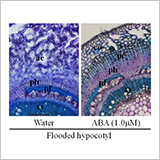 |
Crop Physiology
Potato Stolon and Tuber Growth Influenced by Nitrogen Form
Y. Gao, L. Jia ,B. Hu, A. Alva and M. Fan
- Potato plants supplied with NO3-N (N as nitrate, NO3–) produced more and thicker stolons than those supplied with NH4-N (N as ammonium, NH4+) at tuber initiation stage.
- In the plants fed NO3-N, the stolon tips swelled or formed tubers earlier and produced more tubers than in those fed with NH4-N.
- However, the influence of N form on potato plant growth may vary with the potato growth stage.
Abstract Full Text PDF[513K] |
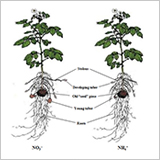 |
Auxin Polar Transport is Essential for the Early Growth Stage of Etiolated Maize (Zea mays L. cv. Honey Bantam) Seedlings
J. Ueda, M. Sakamoto-Kanetake, Y. Toda, K. Miyamoto, E. Uheda and H. Daimon
- The important role of auxin polar transport in the early growth stage of etiolated maize (Zea mays L. cv. Honey Bantam) seedlings was intensively studied.
- Good positive correlations existed among the growth rate, auxin polar transport and the expression of ZmPIN1a gene in coleoptile and mesocotyl of etiolated maize seedlings.
- The results strongly suggest that auxin polar transport regulated by ZmPIN1a protein is essentially required for the growth of coleoptile and mesocotyl in the early growth stage of etiolated maize seedlings.
Abstract Full Text PDF[769K] |
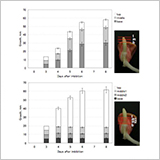 |
Agronomy & Crop Ecology
Open-Top Chambers with Solar-Heated Air Introduction Tunnels for the High-Temperature Treatment of Paddy Fields
M. Chiba and T. Terao
- We have improved the open-top chamber (OTC) by adding a solar-heated air introduction tunnel (SAT) to determine the mechanism of high-temperature tolerance and to screen for tolerant strains in rice.
- A more uniform temperature increase of approximately 1.2 °C in the daytime was achieved by attaching a sloping wall and funnel-shaped air exhaust tunnel to the OTC-SAT to improve the air flow.
- The increase in the percentage of chalky grains with the OTC-SAT was similar to that of the other treatment methods; the OTC-SAT will thus be useful for investigating high-temperature tolerance during the ripening stage, particularly in areas where the wind direction is stable.
Abstract Full Text PDF[1838K] |
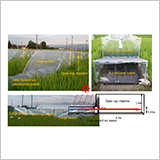 |
Phenotypic Plasticity of Vegetable Amaranth, Amaranthus tricolor L. under a Natural Climate
K.S.U. Khanam and S. Oba
- The plastic responses of fifteen Amaranthus tricolor L. cultivars to the natural climatic conditions across successive two years were investigated.
- Principle component analysis revealed three components (PCs) associated with 67% of the total variation: PC1 includes leaf color attribute a*(red pigment), and photosynthetic pigments (chlorophyll a, chlororphyll b, total chlorophyll), while PC2 accounts for leaf color attribute b* (yellow pigment), betacyanins, betaxanthins and betalains.
- Canonical discriminant analysis (CDA) was an effective method for clear separation or grouping of cultivars that may promote effective management and utilization in crop-breeding programmes.
Abstract Full Text PDF[766K] |
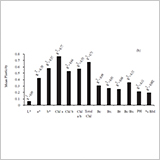 |
Possibility of Introducing Winter Legumes, Hairy Vetch and Faba Bean, as Green Manures to Turmeric Cropping in Temperate Region
K. Yamawaki, A. Matsumura, R. Hattori, A. Tarui, M.A. Hossain, Y. Ohashi and H. Daimon
- Higher values in N and P contents of turmeric were observed in incorporation of hairy vetch.
- Faba bean residues increased total N and P of turmeric by 4.5 g and 1.9 g m–2, respectively.
- In the second year after incorporation of faba bean, nutrient uptake of turmeric was not enhanced.
Abstract Full Text PDF[1173K] |
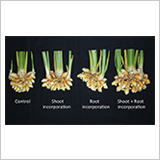 |
Relation between Stem Growth Processes and Internode Length Patterns in Sorghum Cultivar ‘Kazetachi’
A. Fujii, S. Nakamura and Y. Goto
- Sorghum cultivar Kazetachi has a unique internode length pattern, with a wavy shape that changes depending on the cultivation environment.
- This study was conducted to clarify the relation between the final internode length at harvest and the increment of stem growth to establish a method to elucidate stem growth during the growing season.
- Measuring the leaf number in the growth stage and recording the length of internodes and leaf sheaths at harvest can enable estimation of the collar height during the growing season.
Abstract Full Text PDF[1162K] |
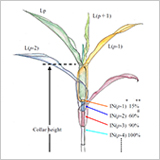 |
Dual and Triple Intercropping: Potential Benefits for Annual Green Manure Production
K. Miyazawa, M. Takeda, T. Murakami and T. Murayama
- We examined the effects of intercropping on biomass, nutrient uptake, and their stability using three green manure species from different functional groups.
- The aboveground biomass was higher with dual and triple-component intercrops compared with sole crops.
- There were no clear advantages of intercropping in terms of the nutrient uptake amount and stability.
Abstract Full Text PDF[680K] |
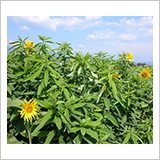 |
Yield and Lodging Resistance of ‘Tachiayaka’, a Novel Rice Cultivar with Short Panicles for Whole-Crop Silage
K. Matsushita, T. Ishii, O. Ideta, S. Iida, Y. Sunohara, H. Maeda and H. Watanabe
- Tachiayaka is a novel cultivar of rice with short panicles that is suitable for use in whole-crop silage.
- The unhulled yield of Tachiayaka was comparable to that of Tachisuzuka, a short-panicle cultivar with high digestibility in cattle.
- Tachiayaka is cultivable in wide area over the Hokuriku to Chugoku regions in Japan, and its lodging resistance is superior to that of Hoshiaoba.
Abstract Full Text PDF[797K] |
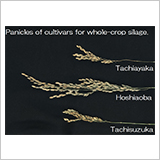 |












